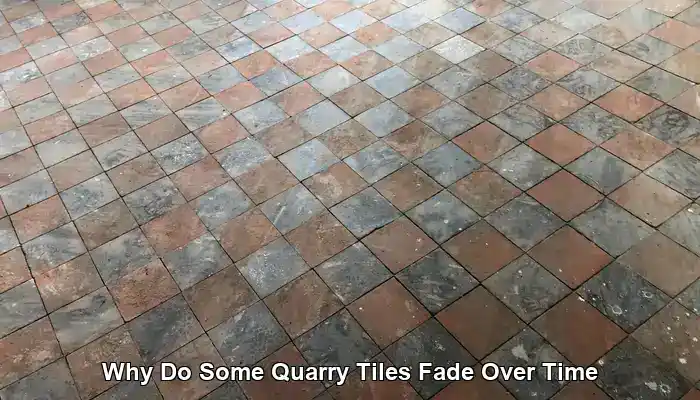
Quarry tiles are celebrated for their remarkable durability, earthy aesthetics, and timeless appeal. Whether they enhance the flooring in a charming kitchen or provide a sturdy foundation for a sun-drenched patio, these tiles are designed to withstand heavy foot traffic and adverse weather conditions. However, many homeowners and property managers notice a gradual fading of their vibrant colours over time, which can occur unevenly and become quite noticeable. This transformation can be puzzling, especially when tiles that once displayed rich shades of reds, inviting browns, or deep terracotta hues start to appear washed out or dull.
The fading of quarry tiles goes beyond mere aesthetics; it can signal underlying issues related to wear, environmental factors, or chemical damage. When exposed outdoors, these tiles face constant challenges from natural elements like rain, frost, and temperature changes that can gradually wear down their surface. The freeze-thaw cycle is particularly harmful, as it can create tiny cracks that lead to surface spalling, exposing lighter inner layers with a coarser texture. For indoor tiles, the issues are different but equally complex. Increased foot traffic can wear away the pigmented surface, revealing the inner body typically composed of larger particles and varied mineral colours. This natural stratification means that once the surface is compromised, the tile’s colour and texture can change drastically, leading to a less appealing look.
Alongside physical wear, exposure to various chemicals can accelerate the fading process. Strong cleaning products, especially those with acidic or alkaline properties, can damage the sealers and wear down protective coatings. Over time, this deterioration leaves the tiles prone to staining, efflorescence (the formation of white salt deposits that lighten the surface), and the gathering of dirt in the newly formed pits and abrasions. These combined factors ultimately contribute to a faded and uneven appearance that detracts from the original beauty and charm of the tiles.
Grasping the reasons behind the fading of quarry tiles is an essential first step toward preserving their unique character and extending their lifespan. In this informative article, we will delve into the various environmental, mechanical, and chemical factors that lead to fading—both indoors and outdoors—and share practical tips for prevention and restoration. Whether you are maintaining a historic floor or simply aiming to keep your tiles in pristine condition, this comprehensive guide will help you understand the intricate science behind quarry tile wear.
Expert Tips for Effectively Maintaining Your Quarry Tiles
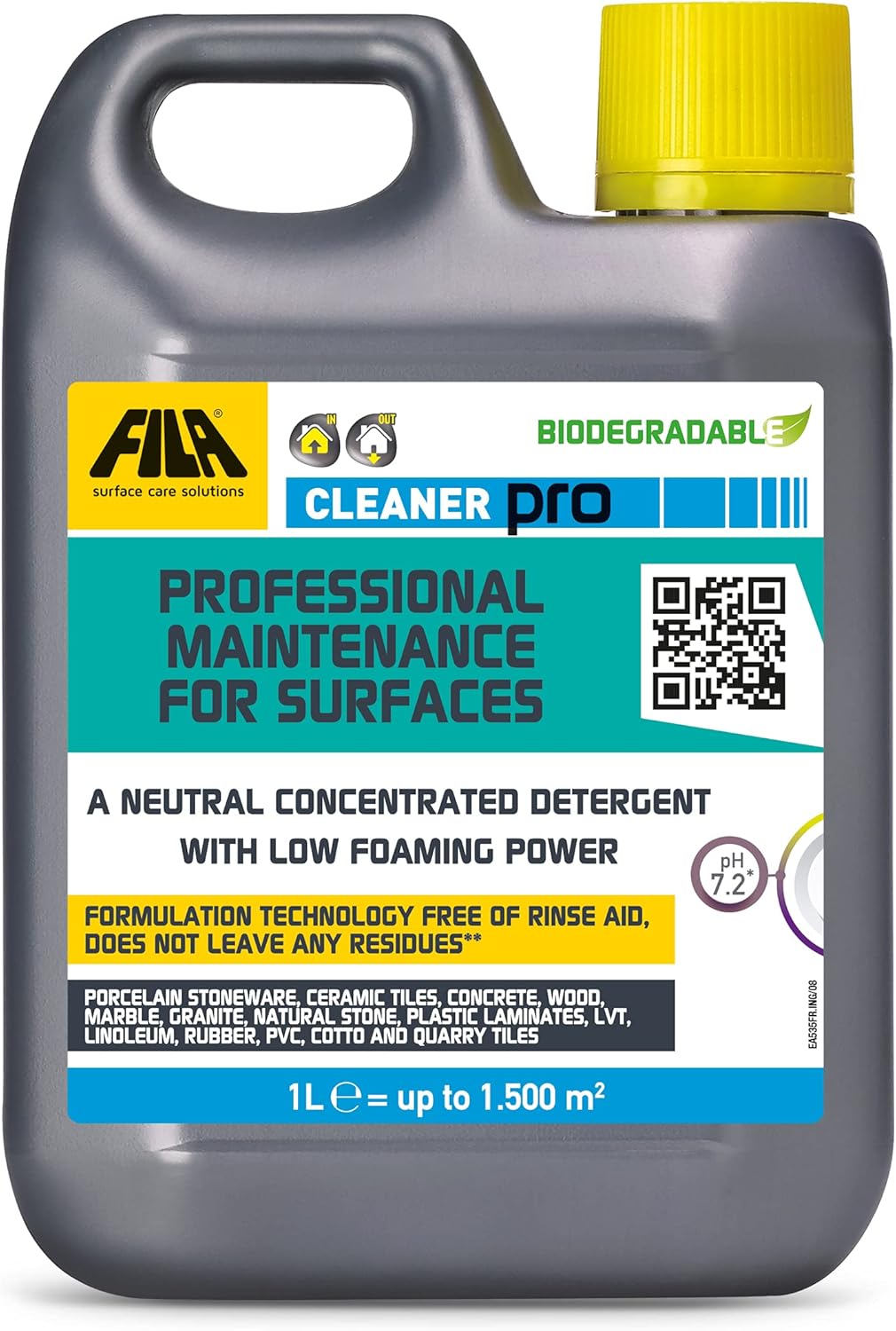
Fila Pro Floor Cleaner
|
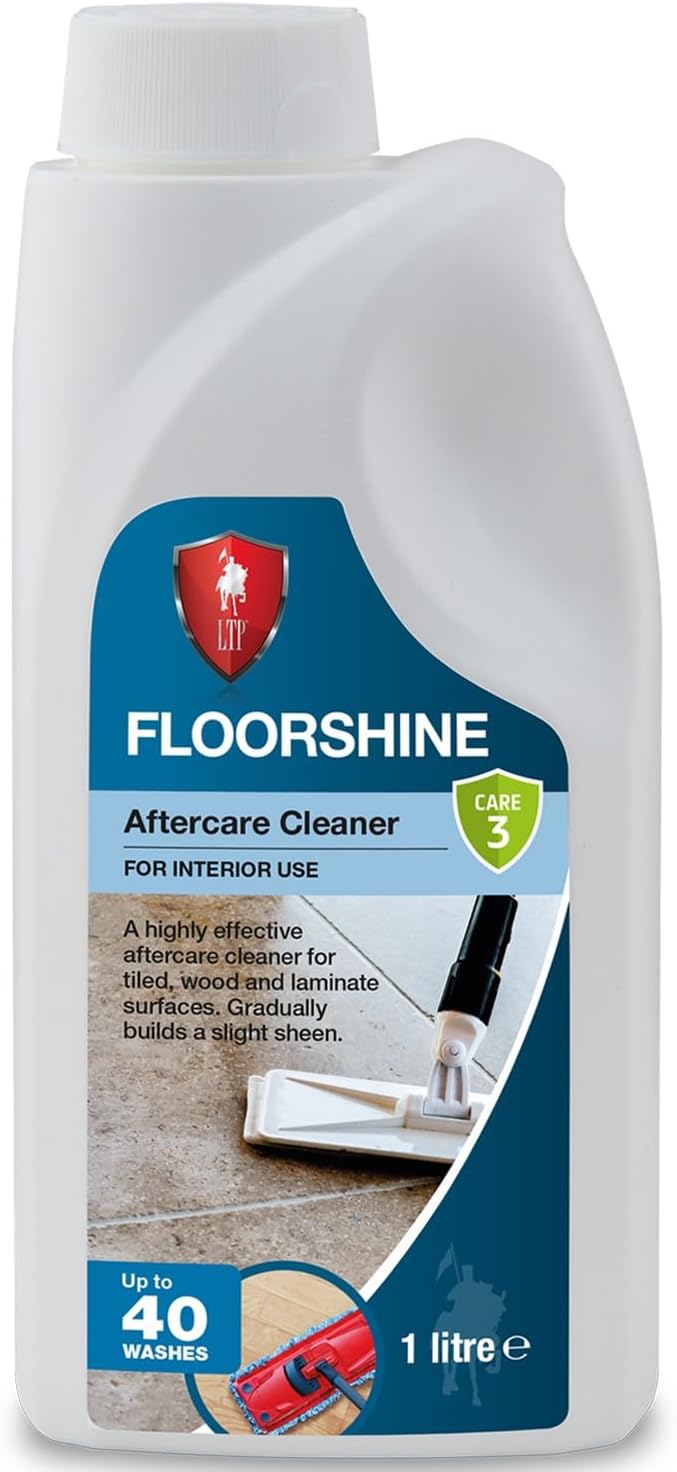
LTP Floorshine
|
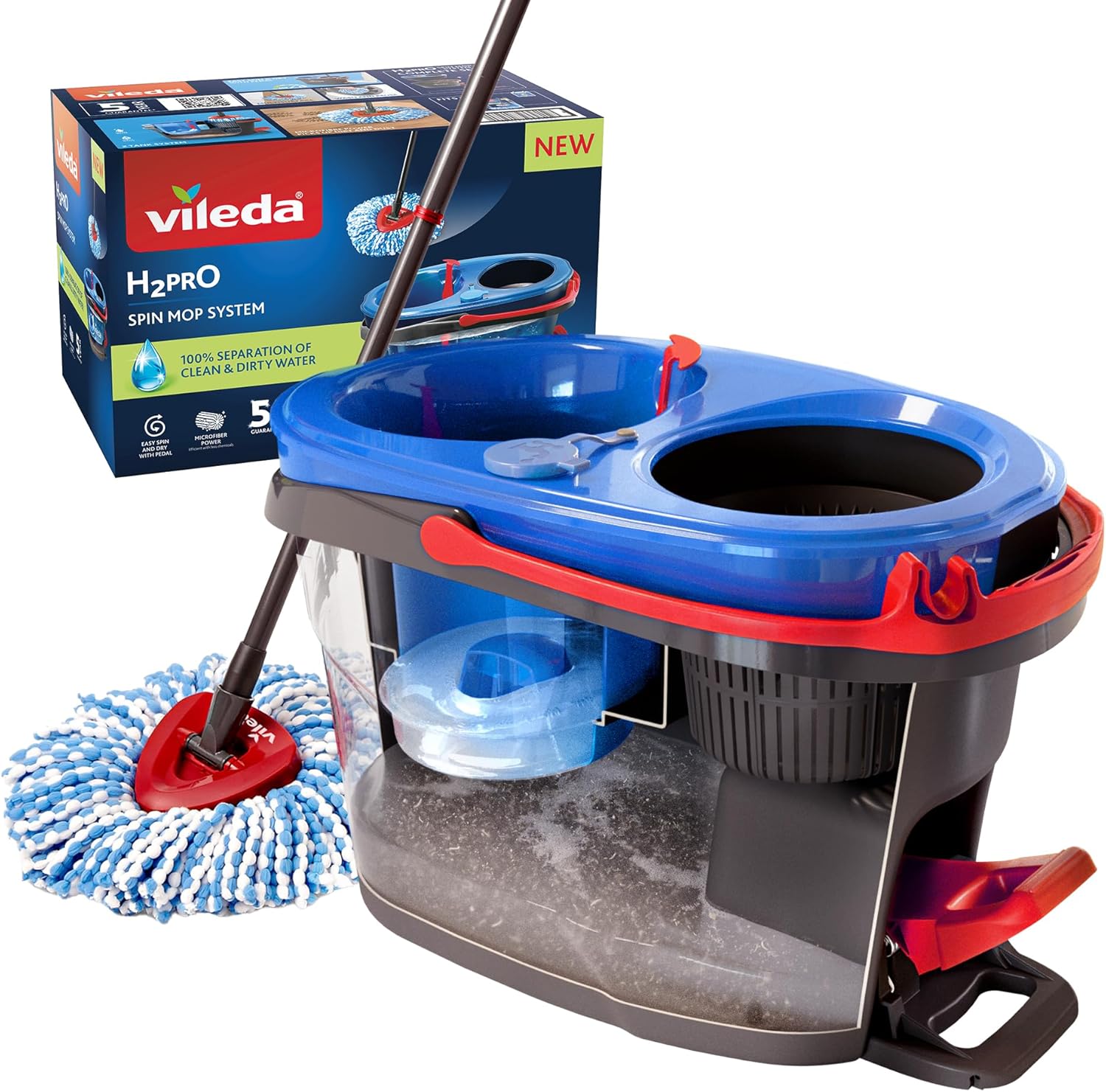
Vileda H2PrO Spin Mop System
|
Exploring the Major Outdoor Environmental Factors Leading to Quarry Tile Fading
Quarry tiles installed in outdoor environments face relentless environmental stressors that gradually diminish their colour and texture. Though these tiles are known for their strength, nature has a remarkable ability to wear down even the most durable surfaces over time.
Understanding the Impact of Weather on Quarry Tile Appearance
Among the most significant factors contributing to fading is the weather, particularly rain and the freeze-thaw cycle. Rainwater can penetrate the porous surfaces of unsealed or inadequately sealed tiles, transporting minerals and contaminants that can stain or leach colour from the tiles. When temperatures drop, moisture trapped within the tile expands as it freezes, causing micro-cracks and surface flaking. This repeated freeze-thaw cycle exposes the inner body of the tile, which often consists of lighter and less pigmented materials, resulting in a dull appearance.
Examining the Effects of Surface Wear and Layer Exposure in Outdoor Settings
Quarry tiles are generally designed with a dense outer layer that retains the most vibrant colours. As this protective layer wears away due to foot traffic, abrasion, or natural erosion, the underlying layer becomes increasingly visible. This inner layer typically has a rougher texture, features larger aggregate particles, and is often a lighter, uneven hue. Consequently, the result is a patchy appearance that lacks the original richness and vibrancy of the tile.
Assessing the Impact of Chemical Damage from Outdoor Cleaning Agents on Quarry Tiles
When cleaning outdoor surfaces, powerful chemicals are often used to combat moss, algae, or grime. Unfortunately, these harsh solutions can degrade sealers and strip away protective coatings. Once the sealer is compromised, the tile becomes increasingly vulnerable to staining, mineral deposits, and accelerated wear. Over time, this chemical exposure significantly contributes to the fading and dullness of the tile surface.
Investigating Indoor Influences That Contribute to Quarry Tile Fading
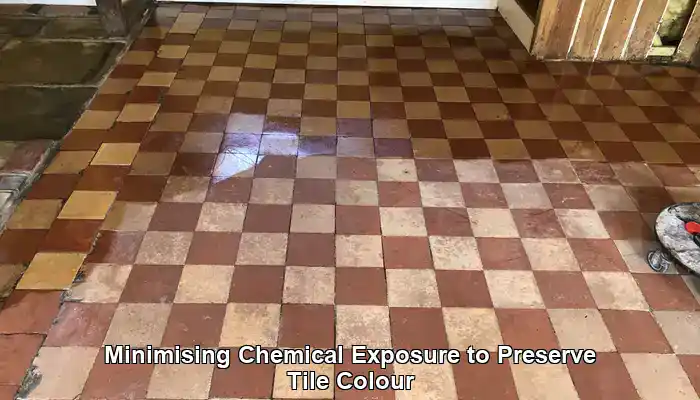
While outdoor quarry tiles contend with harsh environmental elements, indoor tiles encounter a unique set of challenges that can also lead to fading over time. Daily foot traffic and cleaning routines contribute to the gradual and cumulative fading of indoor quarry tiles, driven by wear, surface degradation, and chemical exposure.
Evaluating the Impact of Abrasive Wear and Loss of Surface Crust
Quarry tiles are manufactured with a dense, pigmented outer crust that provides their rich colour and smooth finish. Indoors, particularly in high-traffic areas such as kitchens, hallways, and commercial spaces, this outer layer gradually diminishes. As the surface erodes, the inner body of the tile becomes more exposed. This inner layer typically contains larger mineral particles and is more porous, leading to a noticeable shift in both colour and texture. Earth-toned tiles may begin to show mottled or washed-out appearances, with lighter patches where the crust has worn thin, reducing their overall appeal.
Understanding the Effects of Surface Pitting and Soil Accumulation in Indoor Environments
As the surface of indoor quarry tiles wears down, micro-abrasions and pits begin to develop. These tiny indentations trap soil, grease, and cleaning residues. Over time, the accumulation of dirt in these micro-pits leads to uneven staining and dullness. Even regular cleaning may not effectively remove embedded grime, resulting in a faded and blotchy appearance. This issue is particularly common in older floors that have not been properly sealed or maintained, further exacerbating the fading process.
Exploring the Role of Efflorescence and Mineral Migration in Tile Fading
Efflorescence is another significant factor contributing to indoor tile fading. This phenomenon occurs when moisture trapped beneath the tile moves upwards, carrying soluble salts to the surface. As the moisture evaporates, it leaves behind a white, powdery residue that lightens the tile’s appearance and can cause surface damage. Efflorescence is especially common in areas with poor subfloor ventilation or where tiles are laid over damp concrete. If left unchecked, it can degrade the tile’s surface and complicate cleaning efforts.
Examining How Chemical Overuse and Breakdown of Sealants Affect Tile Fading
Indoor cleaning routines often rely on potent chemical agents, especially in commercial or food preparation environments. While these products can be effective at eliminating grease and stains, they can also strip away sealers and protective coatings. Once the sealer is compromised, the tile becomes more porous and susceptible to staining, wear, and further fading. Acidic or alkaline cleaners can etch the surface, permanently altering its texture and colour. Over time, ongoing exposure to harsh chemicals accelerates the deterioration of both the tile and its finish.
Identifying Essential Maintenance Practices for Quarry Tiles
The fading of indoor quarry tiles can often be prevented with proper care. Utilizing pH-neutral cleaners, adhering to a regular sealing schedule, and steering clear of abrasive cleaning tools can significantly extend the life and aesthetic appeal of the tiles. For older floors showing signs of wear, professional restoration—including deep cleaning, re-sealing, and colour enhancement—can help revive their original beauty and charm.
Implementing Practical Strategies for Preventing and Restoring Quarry Tiles
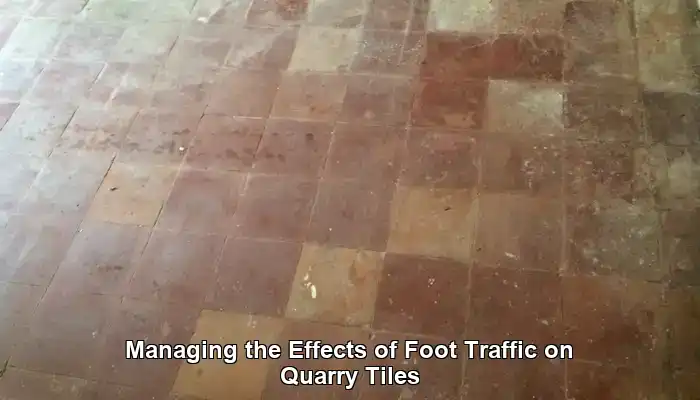
Understanding the factors leading to the fading of quarry tiles is just one part of the puzzle—the true value lies in knowing how to prevent fading and restore their original beauty when wear occurs. Regardless of whether your tiles are installed indoors or outdoors, proactive maintenance and thoughtful restoration can greatly extend their lifespan and preserve their rich, earthy character.
Why Sealing Is the Most Effective Defense Against Fading?
One of the best strategies to prevent fading is through proper sealing. Quarry tiles are naturally porous, and without a protective barrier, they easily absorb moisture, dirt, and chemicals. A high-quality penetrating sealer fills the pores without forming a surface film, allowing the tile to breathe while repelling contaminants. For outdoor tiles, this is especially critical to protect against rain, frost, and algae growth. Indoors, sealing helps prevent staining from spills, cleaning agents, and heavy foot traffic.
Sealers should be reapplied periodically—generally every one to three years, depending on usage and exposure conditions. A simple water-drop test can indicate when resealing is needed: if water penetrates rather than beads on the surface, it signals that a refresh is due.
What Smart Cleaning Practices Should Be Adhered To for Avoiding Harsh Chemicals?
Routine cleaning is essential, but the choice of products for this task is crucial. Strong chemicals, particularly those with acidic or alkaline properties, can degrade sealers and etch the tile surface. Over time, this can lead to dullness, discolouration, and increased vulnerability to staining. Instead, opt for pH-neutral cleaners specifically designed for stone or tile surfaces. These cleaning agents effectively lift dirt without compromising the integrity of the tile.
For persistent grime or efflorescence, utilize targeted treatments sparingly and always follow up with a thorough rinse. Avoid using bleach, ammonia, and vinegar-based solutions, which may initially seem effective but can ultimately cause long-term damage.
What Maintenance Techniques Can Help Preserve Tile Colour?
Regular sweeping and damp mopping are essential practices to prevent soil buildup and surface abrasion. Use soft-bristle brushes or microfiber pads instead of abrasive scrubbers, which can damage the tile’s pigmented surface. In high-traffic areas, consider placing rugs or mats to minimize direct wear—especially near entryways or kitchens.
For outdoor tiles, pressure washing should be approached cautiously. While it can effectively remove surface dirt, excessive pressure may erode the tile or force water into cracks, worsening freeze-thaw damage. If pressure washing is necessary, keep the pressure low and maintain a safe distance with the nozzle.
How Professional Restoration Can Revive Quarry Tiles?
When fading becomes noticeable and routine care fails to suffice, professional restoration can yield impressive results. Restoration specialists utilize a combination of deep cleaning, mechanical resurfacing, and colour enhancement techniques to rejuvenate tired tiles.
- Deep cleaning effectively removes embedded dirt, grease, and mineral deposits using specialized equipment and solutions.
- Mechanical honing or polishing smooths worn surfaces and restores texture, especially for indoor tiles that exhibit surface pitting.
- Colour enhancement sealers can enrich faded hues, particularly in earth-toned tiles, by deepening the natural pigments without adding a glossy finish.
In cases of extensive wear, restoration may also necessitate regrouting, tile replacement, or the application of protective coatings tailored to the tile’s specific environment.
Why Establishing a Long-Term Care Strategy Is Crucial?
Preventing future fading requires a long-term strategy. Create a maintenance schedule that includes regular inspections, cleaning, and resealing. Educate household members or staff about proper cleaning methods and the importance of using appropriate products. For commercial settings, consider working with a floor care professional to develop a customized plan according to traffic levels and environmental conditions.
If your tiles are part of a heritage property or hold historical significance, consult with conservation experts before beginning any restoration efforts. Preserving the authenticity of older quarry tiles often requires specialized techniques and materials.
FAQs: Insights and Answers About Quarry Tile Care
Can Faded Quarry Tiles Be Effectively Restored?
Yes, quarry tiles can often be rejuvenated through deep cleaning, resealing, or even professional refinishing techniques, depending on the severity of the fading. Homeowners should explore various options to revive the beauty of their tiles.
How Often Should Quarry Tiles Be Cleaned?
Regular sweeping should be performed weekly, with more thorough cleaning every few months to maintain their appearance and prevent fading. Establishing a consistent cleaning routine will help protect their vibrancy.
Are There Specific Sealants Designed for Quarry Tiles?
Indeed, there are specialized sealants formulated specifically for quarry tiles that offer protection against moisture and UV rays, enhancing their longevity and aesthetic appeal. Homeowners should consult professionals for tailored recommendations.
Which Cleaning Products Should Be Avoided on Quarry Tiles?
Steer clear of acidic cleaners, harsh chemicals, and abrasive scrubbers, as these can damage the surface and contribute to fading. Instead, use gentle, tile-safe products.
How Can I Tell If My Quarry Tiles Need Resealing?
If water does not bead on the surface or the tiles appear dull and stained, it may be time for resealing. Regular checks can help maintain optimal protection.
Does Indoor Lighting Affect Tile Fading?
Indirect indoor lighting generally has less effect than UV rays, but prolonged exposure to bright light can contribute to gradual fading. Homeowners should consider their lighting choices when designing spaces.
Is It Safe to Use a Steam Cleaner on Quarry Tiles?
Steam cleaners may be too harsh for quarry tiles, potentially harming their surface. It is advisable to stick to recommended cleaning methods to preserve their integrity.
Are Some Quarry Tiles More Prone to Fading Than Others?
Yes, tiles made from inferior materials or pigments may fade more quickly compared to those crafted from high-quality materials. Homeowners should prioritize quality when selecting tiles.
Does Foot Traffic Significantly Impact the Lifespan of Quarry Tiles?
High foot traffic can lead to wear and tear, accelerating fading and increasing the need for maintenance. Homeowners should implement strategies to effectively manage foot traffic on their tiles.
Can Fading in Quarry Tiles Be Fully Prevented?
While completely preventing fading is challenging, consistent maintenance, proper sealing, and the use of quality products can significantly reduce colour loss over time.
The article Why Do Some Quarry Tiles Fade Over Time: A Guide was first found on https://www.abbeyfloorcare.co.uk
The Article Quarry Tiles Fade: Understanding the Causes and Solutions appeared first on https://fabritec.org
The Article Quarry Tiles Fade: Causes and Solutions Explained Was Found On https://limitsofstrategy.com
The Article Causes and Solutions for Fading Quarry Tiles First Appeared ON
: https://ad4sc.com
Comments are closed